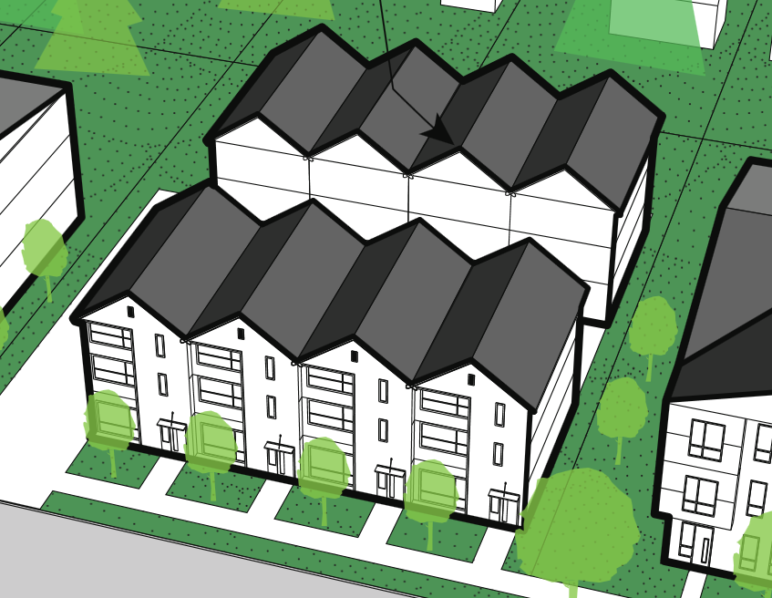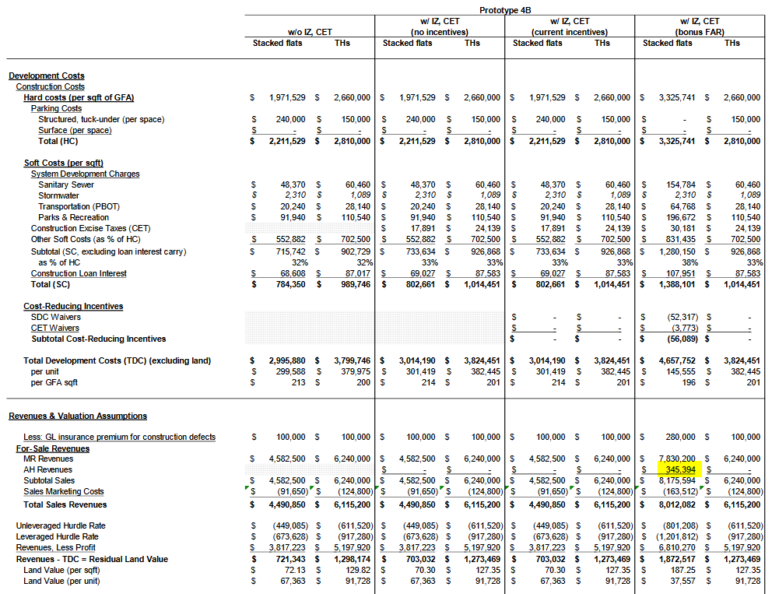For three years, Portland’s proposal to re-legalize fourplexes citywide has been overshadowing another, related reform.
That other reform applies not to low-density lots but to mid-density areas: The ones currently zoned for townhomes and small to medium-size apartment buildings. It’s finally coming before Portland’s city council in a public hearing Wednesday. (The city is also accepting online testimony right now.)

This proposed mid-density reform, dubbed “Better Housing by Design,” includes various good ideas, like helping East Portland’s big blocks include shared interior courtyards; regulating buildings by size rather than unit count; and giving nonprofit developers of below-market housing a leg up with size bonuses.
But one detail in this proposal is almost shocking in its clarity. It turns out that there is one simple factor that determines whether these lots are likely to eventually redevelop as:
- high-cost townhomes, or as
- mixed-income condo buildings for the middle and working class.
The difference between these options is whether they need to provide storage for cars—i.e. parking.
According to calculations from the city’s own contracted analysts, if an average of 1.5 off-street parking spaces per stacked condo unit were required in the city’s new “RM2” zone, then the most profitable thing for a landowner to build on one of these properties in inner Portland would be 10 townhomes, each valued at $733,000, with an on-site garage.
But if off-street parking isn’t required, then the most profitable thing to build is a 32-unit mixed-income building, including 28 market-rate condos selling for an average of $280,000 and four below-market condos—potentially created in partnership with a community land trust like Portland’s Proud Ground—sold to households making no more than 60 percent of the area’s median income.
This is worth repeating: As long as parking isn’t necessary, the most profitable homes a developer can build on a lot like this in inner Portland would already be within the reach of most Portland households on day one.
But if we require parking on these lots, we block this scenario. If we were to require just one space for every two condos, the most profitable building would be more expensive condos with zero below market homes. And if stacked flats had to come with 3 parking stalls for every two units, the most profitable thing to build becomes, instead, a much more expensive townhome.
When people say cities can choose either housing people or housing cars, this is what they’re talking about.
Fellow nerds: Here are the numbers
Here’s the math, as calculated last year by real-estate economics firm EPS Inc.
First, some necessary jargon: “stacked flats” refers to a series of one-level condos on top of each other, arranged in a building looking something like this:

“Townhomes” refers to homes attached to each other at the side, looking like this:

We’re interested in what the analysts referred to as “prototype 4”: a hypothetical 100’x100′ lot (maybe assembled from two or more smaller lots) in the new RM2 zone in an “inner neighborhood” of Portland. EPS ran numbers on a “stacked flats” condo project and a “townhomes” project on this lot. (They considered rental homes, too, but concluded that occupant-owned homes would be a bit more financially feasible in this zone than rental homes.)
First, EPS added up the costs and probable revenues of such projects if they have parking. You can see their estimates in the rightmost column of the table below. (The other columns refer to different regulatory scenarios.)
Check out the number I highlighted. If someone tried to create 1.5 parking spaces for each stacked-flat home on a lot like this, they’d end up having to pour almost three quarters of a million dollars into a 24-car garage: Well, it turns out that constructing a small apartment building with a $720,000 garage is an unprofitable business venture. EPS calculates that this additional expense would sink such projects. The likelier outcome would instead be 10 much more expensive townhomes, which is the project type represented by the tallest bar below:
Well, it turns out that constructing a small apartment building with a $720,000 garage is an unprofitable business venture. EPS calculates that this additional expense would sink such projects. The likelier outcome would instead be 10 much more expensive townhomes, which is the project type represented by the tallest bar below:
Then the analysts flipped one switch—the presence of parking—and everything else changed, too.
See the number I highlighted in the revised table below, “AH revenue”? That’s the amount of money the developer would be bringing in, total, from the four “affordable housing” homes under the parking-free scenario 4B. Notice how none of the other scenarios include that figure? That’s because none of the other scenarios here would create any below-market housing. This project would.
Notice how none of the other scenarios include that figure? That’s because none of the other scenarios here would create any below-market housing. This project would.
The parking-free stacked flats scenario (4B) still includes market-rate homes too: 28 of them in this case. But if you look at the number immediately above the one I’ve highlighted, you’ll see the developer would be bringing in about $7.8 million total from those homes—an average of $280,000 each.
With 20 percent down and a mortgage interest rate of 3.9 percent, that comes out to a monthly payment of $1,390, including taxes and insurance, for a small, newly built home in inner Portland.
And—I’m just going to point this out a third time—this building full of middle- and working-class homes would be the most profitable thing someone could build on this land, as shown by the rightmost bar below: That’s a lot of charts and figures.
That’s a lot of charts and figures.
But for the people who would live in these homes, having a stable home they could afford in central Portland would be an extremely concrete blessing in their lives. Even if it means parking their car, if they have one, on the street.
Many projects will include parking, but that doesn’t mean the city should require it
The bad news is that it’s far from certain that many developers—or, more to the point, the banks that issue developers’ construction loans—would actually choose to build 32-unit buildings without off-street parking. It just isn’t easy enough yet to get around Portland without a car.
If banks decide they simply have to have lots of off-street parking in order to sell these homes, goodbye stacked flats; hello townhomes. Goodbye, affordable community land trust homes. Goodbye, market-rate homes for the middle class.
That’s depressing, and it’s one of the many reasons cities should be investing heavily in making low-car life possible for more people.
But Portland is currently proposing something downright foolish: It wants to keep requiring garages on some of these lots. The mandate would apply to any lots that are more than 10,000 square feet, more than 500 feet from a frequent-service bus stop, and more than 1,500 feet from a rail stop.
As the numbers above show, the city may as well be banning below-market housing from many lots that don’t meet that standard, including lots that may be zoned “RM2” in the future. And every lot where the city requires parking shuts the door to future entrepreneurs who might come up with creative ways to help people avoid car ownership.
More broadly, there’s an issue of principle here that could apply in any city: Mandating off-street parking, even when we’re fully aware that it makes more and cheaper homes impossible, requires a judgment that housing cars is more important than housing people.
Nowhere in Portland—nowhere on the planet—is that true.
Take it from Portland’s mayor, Ted Wheeler, who said the following a few months after coming to office:
“I want to put a marker down. The debate: Parking vs. Housing? It’s really over. That piece of the conversation is over. When younger families or younger people say they want to locate here, the first thing they’re saying isn’t ‘Boy I wish I had another parking space, or had access to a parking space.’ What they’re saying is, ‘I can’t afford to live in this city.’ And, so, the city, meaning the debate that happened over the last three years actually made a choice, and the choice was affordability and housing over access to parking. I just want you to be aware that that is a real dynamic and is a real choice and it was made with full community involvement.”
I don’t always agree with Mayor Wheeler. But I can’t disagree with any of that.
Correction 10/29: An earlier version of this post repeated several errors that stemmed from a clerical error by EPS, the city’s consultants on this project. EPS had described their model for townhomes as reflecting a 1:1 parking ratio rather than the 0.5:1 ratio actually modeled by the rightmost column in the first table shown above. EPS had also described their model for stacked flats as reflecting a 0.5:1 parking ratio rather than the 1.5:1 ratio actually modeled. If EPS’s models had used the ratios promised in their narrative, they would have found these results for “prototype 4” instead: assuming the market does not demand on-site parking, 32 stacked flats without parking would be most likely to be built, followed by 19 stacked flats without parking, followed by 16 stacked flats with parking (at 0.5:1), followed by 10 townhomes with parking (at 1:1).
So it’s still parking that determines which scenario is most likely, but the switch from townhomes to flats occurs at a different parking ratio than the earlier version of this post claimed. EPS has confirmed these revised figures. Thanks to reader Judi Draper for calling this to our attention in the comments below.


Comments are closed.